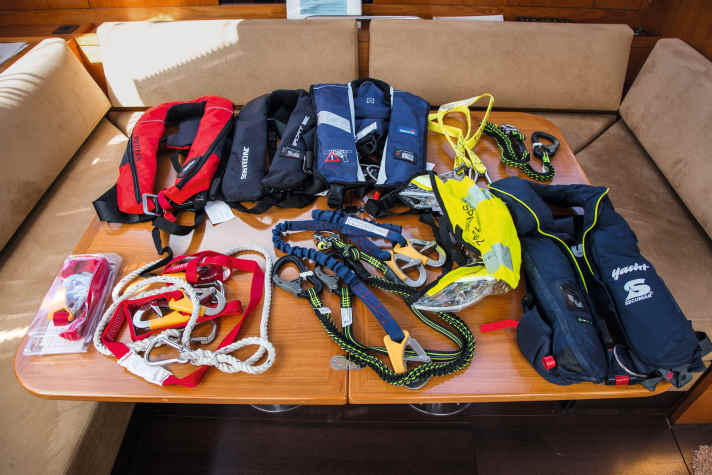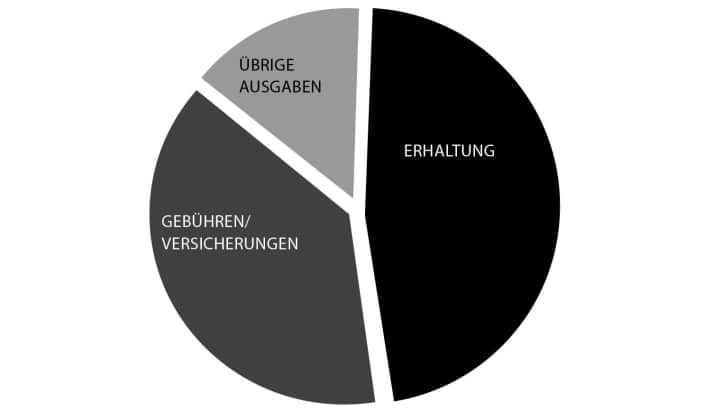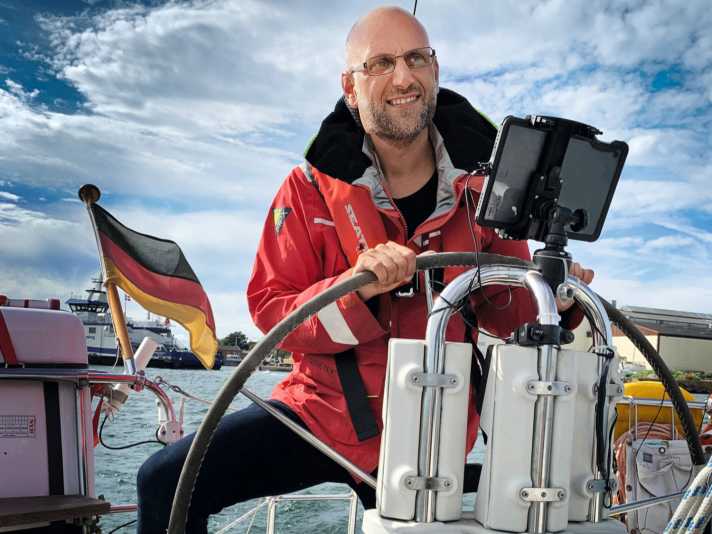





- Bureaucratic hurdles for private charters
- The right boat for a private charter
- Number of cabins for the private charter
- Scope of equipment at the Private charter
- The way to new private charter customers
- Conclusion
- Is Private charter e a profitable business?
- Experience and requirements
- Keeping an eye on expenditure
Chartering out your own yacht, also known as a private charter, can be a lucrative way to reduce maintenance costs or even make a profit. Some owners secretly flirt with the idea of consolidating their on-board funds in this way.
If you are seriously considering a private charter, the first question you should ask yourself is whether you could tolerate other people using your yacht. Not everyone is comfortable with the idea of strangers sleeping in their own berth or using the on-board cutlery and toilet.
In addition to personal sensitivities, it must also be accepted that the charter guests leave traces of use behind that would only occur later or not at all if the boat was used exclusively by the charterer.
It should also be borne in mind that the intensive use of a private charter can also lead to structural losses, such as reduced rigidity, soft spots in the hull or a shortened service life of sails, engine and technical equipment.
On the other hand, too little use can also have disadvantages for the boat and its condition.
Whether a private charter makes sense will vary greatly from person to person. If the decision is in favour, there are various aspects to consider before signing the first charter contract.
Bureaucratic hurdles for private charters
A fast motorised vehicle with flashing blue lights approaches the charter crew from starboard abeam. When the friendly ladies and gentlemen of the coastguard have reached the charter boat, the officers ask, among other things, for the boat documents to be handed over. Now the charterer hopes that the charter company has done its job properly and that all the required documents are correct and complete.
An important first step in a private charter is therefore obtaining the necessary licences. The requirements can vary depending on the country and region. In many countries, a special charter licence is required, which is often linked to certain safety standards and equipment requirements.
In addition, the yacht and its equipment must be regularly maintained and inspected to ensure that they comply with legal requirements.
In Germany, there are strict regulations that must be observed when chartering a yacht. In addition to the general suitability of the vessel, which must be proven by CE certification or equivalent evidence, equipment obligations must also be fulfilled.
Minimum equipment for a bare boat private charter

A sailing yacht with an auxiliary engine under twelve metres for up to six people requires a minimum bareboat charter in the Baltic Sea:
- Position lights
- Anchor lantern
- Anchor ball, signalling cone, fog horn
- Two 2 kg powder extinguishers
- Sumlog, magnetic compass, bearing compass
- Radar reflector
- Binoculars
- Hand lamp with morse key
- Two lifebuoys/collars, one with line and light
- Fully automatic lifejackets or solid-fuel lifejackets, number according to number of persons
- Stretch ropes, one life line per person, life raft
- Signalling equipment: four red parachute signals, four red hand flares, two orange smoke signals
- Signal flags "N" and "C"
- Federal flag
- First aid kit
- Anchor with chain and line
- Towing hawser, 50 m length
- Boat hook, throwing line
- Fender
- Four mooring lines
- Handheld or echo sounder
- Receiver (Radio/Navtex)
- Barometer, on-board clock
- Logbook
- Nautical charts, nautical handbook, list of beacons
- Navigation aids
- Bow and stern pulpit, guard rail, outboard steps
- Valves on fuel tanks
- Holding tank (exception: hull length < 10.50 m or width < 2.80 m or year of construction before 1 January 1980)
- Spare parts, leak sealing material, tools
- Reefing device, storm sail
- Bolt cutters, hatchet
Application for a boat certificate
If the yacht is equipped in this way, the next step is to apply for a boat certificate from the responsible waterways and shipping office (WSA). This certificate is required in order to obtain the licence plate, which must later be clearly visible on the stern of the charter yacht.
Inspection and testing
Before issuing the boat certificate, the WSA will arrange an inspection appointment to check compliance with the requirements. This inspection must be repeated every two years. This ensures that all safety-relevant components are still present and functional. In addition, the specified service and inspection intervals, for example for life jackets, life rafts, gas cookers or distress signalling equipment, must have been adhered to.
The general condition of the yacht is also assessed. Particular attention is paid to the condition of the standing rigging, the passages on board and the steering gear. A well-maintained and well-kept yacht usually passes this inspection within an hour.
Tip for smooth testing
To speed up the inspection process, it is advisable to place all relevant items of equipment together on the salon table. This allows the inspector to check them quickly before returning them to their original storage location.
The right boat for a private charter
Beauty is in the eye of the beholder, and this also applies to boats. There is an impressive variety of boats, but not every one is suitable for a private charter. However, if a charter crew is not only to be acquired on a one-off basis, but also to actually benefit economically from the rental in the long term, the prospective charter company should carefully check whether its boat fulfils the necessary requirements:
1. easy handling
Can an inexperienced crew operate your boat safely in a reasonable amount of time? Simple, user-friendly handling is crucial. If your yacht requires special tricks, such as simultaneously pushing a door with your foot and gently pressing the door handle to open it, this could lead to problems in charter operations. This would result in constant queries from charter guests, which would not be pleasant for you or the hirers.
It doesn't have to be the latest model, but for the safety and satisfaction of the crew it is advantageous if the boat is solidly built, well thought out and robustly equipped.
It is an advantage if the yacht for the private charter is from a renowned and sought-after brand such as Hallberg-Rassy, Hanse, Dehler or Bavaria. These yachts are generally easy to handle, even if they have been around for a few years.
2. spare parts position
How easy is it to get hold of spare parts for your yacht if the worst comes to the worst? No matter how carefully your guests handle the yacht, there will always be minor or major damage. Whether it's a crushed engine panel cover, a broken fire extinguisher bracket or a damaged rudder blade - many things can break during a charter.
It is therefore important that spare parts for your boat are easy and reliable to obtain. A widely used model for which there are specialised dealers with a well-stocked spare parts warehouse offers clear advantages here.
Even if the spare parts from well-known manufacturers may be more expensive, it is reassuring to know that your boat will not be stuck in harbour for weeks because a part is not available.
The same applies to repairs: if your yacht is highly customised and difficult to maintain, this can lead to significant problems over time.
3rd target group
Does your yacht fit the target group you want to address? The design of your boat plays a decisive role in chartering. If your yacht is spacious but only designed for a small crew, you must expect that the target group will be prepared to pay a higher price per head.
Number of cabins for the private charter
A good guide is the number of cabins: smaller crews are often happy with two cabins. However, as many yachts up to 31 feet fulfil this criterion, it may be difficult to find charterers willing to pay a higher price for a 34 or 40-foot yacht for the same number of cabins.
Yachts from 34 feet should ideally have three or more cabins. This means that your boat will not only appeal to families who value comfort, but possibly also to groups such as stag parties who are looking for an attractive price per head.
Here it is important to be clear about the clientele you want on board and how this might affect the care and condition of the yacht.
In addition to the number of cabins, the personal taste of your guests also plays a decisive role. A clean and well-maintained first impression of the yacht is important, but the sailing characteristics in wind and waves are just as crucial. Not every charter guest is looking for a floating living room that is only moderately manoeuvrable over the water.
Many sailors prefer older boats with a classic outline and outstanding sailing characteristics to a modern space-saver. Such yachts are particularly appealing to charter crews who prioritise the sailing experience and performance.
Scope of equipment at the Private charter
The dimmable underwater lighting bathes the water behind the yacht in a fascinating play of light that inevitably attracts attention. The skipper taps skilfully on the ultra-modern display and has the route for the next day calculated automatically.
Technical development has also made great progress in the yachting industry and brought many innovations with it. But what technology is really necessary to make a charter yacht attractive, and what gimmicks can you do without to avoid unnecessarily high maintenance costs?
Experienced sailors who have been practising their hobby for decades still remember the days when a clicker, a log, a depth gauge and a handheld GPS device were all that was needed. Many older boats without modern high-tech equipment are still popular for chartering today.
Nevertheless, modern technology such as the bow thruster, the chart plotter or a wind display that graphically shows the apparent wind can tip the scales for undecided charter customers.
After all, such extras make handling easier, which appeals not least to less experienced sailors, and make the boat more attractive overall. On yachts that are difficult to manoeuvre, a bow thruster can lead to less damage to the hull, the bow and stern pulpit and the railing supports over the course of the yacht's charter life.
However, all additional technical equipment harbours a certain risk for the charter company: the more technology on board, the more can break down. Repairs or the replacement of defective components often result in high costs.
Tip
An overly modern or fully equipped yacht is not absolutely necessary for a private charter. Think about which technical features are really necessary to attract more charter guests - and remove anything that does not contribute to increasing the attractiveness of your yacht.
The way to new private charter customers
In order to actually make a profit from chartering out your own yacht, you need to reach the right customers.
One of the biggest challenges here is marketing. Because even the best-equipped yacht needs to be publicised to potential charter customers. Whether through specialised charter agencies, traditional advertising or modern online platforms - each method has different advantages and disadvantages that you should weigh up carefully.
Marketing
Before you decide how to market your yacht for private charter, the question arises: How much do you want to and can you do yourself? Marketing not only takes time, but can quickly become expensive - especially if you call in professional help. It is therefore important to consider the effort involved in relation to the expected bookings.
For yacht owners who only want to charter their yacht occasionally, working with a specialised charter agency can be a good solution. These agencies take on most of the marketing and administrative tasks and list your yacht in their charter catalogues.
This saves you the expense of having your own website or time-consuming online marketing. You simply communicate the available times and the agency takes care of the interested parties and often also handles the bookings.
Charter agency
Most charter agencies charge around 15 per cent of the charter turnover as commission for their services. At first glance, this may seem high, but the relief associated with the agency is a considerable advantage, especially for yacht owners without marketing experience. This is because the agency ensures the visibility of your yacht, takes care of the booking process and relieves you of the bureaucratic burden.
Some agencies offer additional services such as cleaning the yacht or handing it over and taking it back. These services are usually subject to a charge and are not always available in every marina - it's worth taking a close look here.
Own marketing
If you are planning to charter out your yacht more frequently, it could be worth setting up your own website or social media presence. This gives you more control over your company's public image and allows you to communicate directly with potential customers. While such an approach requires time and expertise, it can lead to higher profits in the long term - especially if you manage to gain regular customers as a result.
You should be aware that some charter agencies have clauses in their contracts that entitle them to commission on subsequent bookings - often up to two years after the first booking.
Conclusion
The decision whether to use a charter agency or your own marketing depends primarily on your objectives and the planned utilisation.
If you only want to charter occasionally and want to minimise the effort involved, it makes sense to work with an agency. However, if you are looking for long-term income and greater control, you could benefit from an independent marketing approach.
It is important in both cases: Good customer service and the condition of your yacht are crucial to retaining charter guests in the long term.
Tip
If you want to charter intensively, it may make sense at the beginning to use a mixture of your own marketing and a charter agency.
Consider which advertising and sales channels you can manage cost-effectively yourself, and at the same time engage a charter agency to offer your yacht.
In this way, you slowly build up your marketing yourself and can also market free charter weeks more quickly with the support of the charter agency.
Is Private charter ea profitable business?
The dream of owning your own yacht symbolises freedom and exclusive adventures on the water. But this freedom comes at a price: maintaining a yacht entails considerable running costs. One obvious idea is therefore to rent out the boat to reduce the financial burden.
What may seem like a simple solution at first glance, however, requires careful calculation, as additional expenses can quickly put a strain on the balance sheet. The first question to ask yourself is how often you actually want to charter out your yacht.
A yacht is only profitable if the income from the rental covers the additional costs. In addition to extensive safety equipment, these include the regular boat licences required for commercial operation.
Maintenance and inspection intervals must also be adhered to at shorter intervals than you would possibly do if you were only using the yacht yourself. While a two-year-old chart may still be used in the private sector, this is not permitted when chartering out.
One point that is often overlooked is the increased wear and tear. Every time the boat is handed over to someone else, the strain increases. This not only leads to more maintenance work, but can also reduce the resale value in the long term.
In addition, there are higher costs for berths in popular charter areas and special insurance policies that cover possible damage during the charter - these are generally more expensive than standard policies.
The decision to charter a boat should therefore be well thought out. In addition to the potential income, you also need to keep a close eye on the hidden costs before you sign the first charter contract.
Expected income
To get an idea of what charter prices are realistic for your yacht, it is worth taking a look at the offers for comparable yachts from established charter agencies.
For example, a Dehler 34 from 1989, depending on the season, fetches between 900 and 1,300 euros per week. However, agency commissions, discounts for early bookings or long-term rentals and VAT, if applicable, must be deducted from this amount in addition to the operating costs. This leaves a net gross profit of around 800 to 1,000 euros per charter week.
The author's charter yacht provides a concrete example: in the 2022 season, in which it was chartered out almost continuously, the "Yolo" generated a turnover of around 21,500 euros.
On the cost side, it should be noted that many tasks, such as care, maintenance and cleaning, were carried out by the company itself, which significantly reduced expenditure. For example, the underwater hull is regularly dived by the company itself - a service that normally costs between 80 and 120 euros per dive. For smaller repairs and maintenance work, hourly rates of 80 to 120 euros plus travel costs must be factored in when outsourcing.
In addition, one-off investments totalling EUR 6,400 were incurred in 2022, including for frequent journeys to the yacht by car, a new deck covering, a cool box and a tablet. As these expenses do not recur annually, they have been excluded from the ongoing cost calculation.
Overall, the annual operating costs therefore totalled around 8,500 euros - a figure that is, however, heavily influenced by the fact that many tasks were carried out in-house. If you want to outsource more tasks, you have to plan for correspondingly higher expenses.
Experience and requirements
For many owners, chartering out their own yacht sounds like a tempting way to reduce running costs or even generate additional income. But it's not as easy as it seems at first glance. In my first season as a charterer, I learnt valuable lessons that I would like to share with others today.
Choosing the right charter agency
A key step was the decision in favour of a reliable charter agency. They not only took over the marketing, but also handled the entire booking and payment process. This takes a lot of pressure off and ensures that all legal requirements are met in this area of chartering. A good agency is worth its weight in gold and makes it much easier to get started with chartering.
Insurance claims and transfers
However, unexpected problems cannot always be avoided. One case that has stayed with me for a long time was a charter guest who caused damage to the yacht through improper handling. Fortunately, the charter insurance stepped in and covered the repair costs. However, the incident showed me how important comprehensive insurance is. I have also learnt to meticulously document the condition of the yacht at every handover and return. A detailed handover report is essential in order to avoid trouble later on.
Good planning is half the battle
Chartering out your own yacht can pay off - but only if you are well prepared. If you are prepared to overcome these hurdles, you will be rewarded with an exciting opportunity to share your passion for sailing with others and reduce your maintenance costs at the same time.
Keeping an eye on expenditure
In the first year, necessary investments must be taken into account in order to get the yacht in a charterable condition - especially if a boat certificate is required. These initial costs often mean that no profits can be expected in the first two to three years. However, the intention to make a profit must be recognisable, as otherwise the tax office will assume that the yacht is a hobby and will not grant tax benefits.

After all, the yield depends heavily on how often and on what terms the yacht is rented out. The three categories include the costs for:
Conservation
- Colours
- Lacquers
- Gelcoat
- Engine oil
- Care products, lubricants and cleaning agents
- Light bulbs
- Small items such as screws and shackles
- Batteries
- Maintenance of engine, technology and sails
- Keel work by the shipyard and the slipway to get the boat ashore for this purpose
- Replacement of lost items, for example from the pantry
In the underlying example, these expenses with 4100 Euro The majority of the costs are incurred by the
Fees/insurance
- Summer and winter berth,
- General car park charges and costs of monetary transactions
They amount in total to 3,200 Euro.
Other costs
- Expenses for current electronic and paper maps
- Postage costs
- Renewal of first aid material
- Kitchen equipment
- Storage boxes
- a new handheld hoover
- Smaller tools
- Gifts for guests
- Reimbursement of travelling expenses
These add up to 1,200 euros.
The author

The business graduate is chartering out his Dehler 34 "Yolo", built in 1989, for the fifth season and knows exactly what advantages and disadvantages this has. wellenrauscher.de

